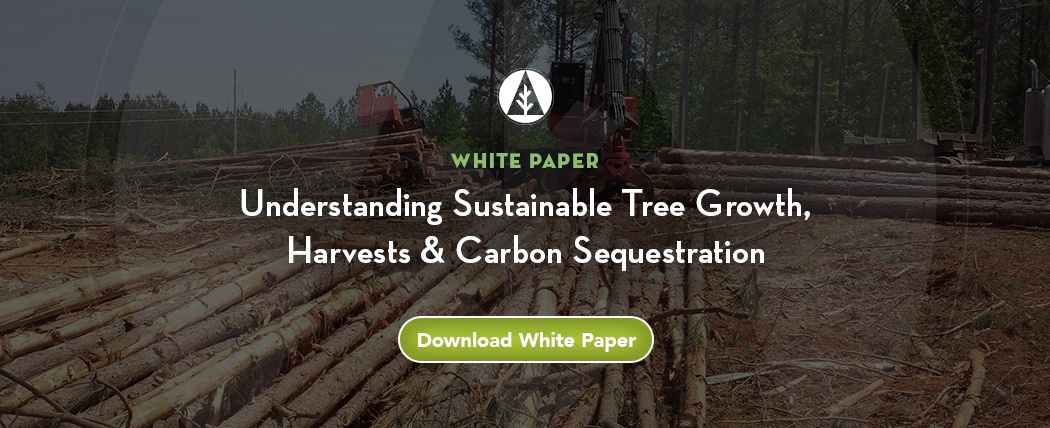3 min read
Sowing What You Reap: Replanting After a Timber Harvest
John Greene
:
Apr 1, 2022 12:00:00 AM

Advocacy for the myriad benefits of working forests is increasingly important, and Forest2Market strongly believes that replanting after a harvest is an essential part of effective timberland management plans. By assisting nature in the recovery of the land after harvest, timberland owners can have a positive impact on their lands well into the future.
Significant financial benefits are attached to the healthier, larger trees that result from well-planned reforestation efforts, and timberland owners will benefit from a high-value harvest in the future when their trees have reached maximum value as sawtimber. Having growing stock on land also increases the potential sales value of the property.
The processes (and related costs) involved in regenerating timberland after a harvest can include any combination of the following: pre-harvest planning for reforestation, site preparation, soil nutrient and herbicide applications, and procuring seeds or seedlings. For any individual timber tract, the total costs for reforestation will vary depending on the condition of the land after the timber harvest, the terrain, the geographical location, and the size of the tract.
To help offset reforestation costs, state and federal cost share programs have been created to provide timberland owners with an incentive to reforest, however. (Information about cost share programs is available at your state forest service office.)
Site Preparation Planning
Preparing a site for regeneration is a critical step in any forest management plan. Proper site preparation shortens the time until the timber can be harvested and helps maximize timber value at the time of harvest. Site preparation generally involves three steps:
- clearing logging debris to provide site access
- reducing competing vegetation to make sure the seeds or seedlings get off to a good start
- preparing the soil to promote drainage and strong root growth
Site preparation tools and techniques vary depending on the condition of the tract to be replanted, the species being planted, and the regeneration method being used; no single approach is appropriate for all situations.
The first step in site preparation involves clearing logging debris from the site. Mechanical site preparation is often used to remove logging debris from a timber tract, though it is the most expensive method of doing so. To remove debris, a drum chopper can be used to reduce slash and small residual trees to smaller pieces that can be left on site to provide nutrients and prevent erosion. Another method is the shear, rake and pile method, which is typically used for tracts with larger amounts of debris and residual trees. Once the standing stems are sheared, all the debris and brush is then raked and piled. Piles can be left to decompose, or they can be burned.
A prescribed burn is the least expensive tool for dealing with excess debris on a harvested timber tract. Because of the risks involved, prescribed burning must be carried out according to state regulations and industry best practices. These generally include the creation of a fire lane that can be used to manage the fire. This is a onetime expense, however, as the lane should be maintained for future site preparation and fuel-reduction burns on the same tract.
In order to reduce risk, prescribed burns should only be carried out by professionals who have the training and equipment to manage the fires. Timberland owners who attempt this treatment without professional help can be held liable if a fire jumps a fire line and becomes a wildfire. The smoke released during a burn can also create a liability issue, as dense clouds of smoke may cross highways and cause accidents.
A prescribed burn can also be used to kill brush and other unwanted stems before replanting, thereby reducing competition between existing vegetation and the seeds or seedlings of the desired, higher value species being planted. Prescribed burning is often used in conjunction with mechanical methods as a way to control vegetation—in between two rounds of drum chopping, for instance.
Chemical treatments are also used to reduce competing vegetation. Because herbicidal treatments can target specific species for removal—specifically controlling hardwood growth on pine stands, for instance—it is often the most effective method. Herbicides are also effective at reducing weedy competition during the first year or two after planting, which is a critical period in the regeneration process. Herbicides are often applied using aerial methods if a site is difficult to access, or by ground methods on flat, easy-to-access sites. Most states also have regulations and best practices for herbicide use as well.
The final step in the site preparation process is soil preparation, and the two most common methods of reducing soil compaction are mechanical: disking and subsoiling. Disking is used when only the top few inches of soil need to be loosened. Studies show this method improves the survival rate of young pines. Soil compaction is a much deeper problem on some land, especially reforested agricultural tracts. For these sites, subsoiling is necessary. This involves a shank being pulled at a depth of 12-18 inches in order to break up the compaction and improve drainage. On particularly wet tracts, the practice of bedding is also used in order to improve drainage. A bedding plow creates mounds of well-aerated soil that allows the root system to develop above the water table.
Tract appropriate site preparation improves the number of trees that are established in a timber tract, and it also improves the health and size of the trees for future harvest. If a site is left debris-free after a harvest, the cost of preparation drops significantly. As a result, the first step in any site preparation plan should be a clause in the timber sales agreement outlining requirements for how the timber tract should be left after harvest.
Timberland owners contemplating a final harvest should employ a professional forester to help identify the best approach for each individual tract. Additionally, state forestry commissions provide a wealth of information specific to common forest types and conditions in each state, which can also be beneficial to timberland owners.





